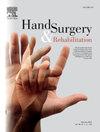A 20-year national decline in wrist fractures: Unraveling trends and persistent challenges
IF 1
4区 医学
Q4 ORTHOPEDICS
引用次数: 0
Abstract
Background
Wrist fractures are among the most common upper extremity injuries. Despite their prevalence and significant societal and healthcare costs, long–term epidemiological data on national wrist fracture trends remain limited.
Methods
This retrospective study analyzed data from the National Electronic Injury Surveillance System (NEISS) and U.S. Census data to evaluate national trends in wrist fractures from 2004 to 2023. Utilizing weighted sampling techniques, incidence rates were calculated, and demographic patterns, causes, and differences between athletic and non–athletic injuries were assessed. Statistical analyses included regression models, chi–square tests, and injury proportion ratios (IPR).
Results
Over the twenty-year study period, there were a reported 106,929 wrist fractures, representing 4,040,516 cases nationwide (95% CI: 3,414,316–4,666,716). The incidence declined significantly over the study period from 78.04 per 100,000 person–years in 2004 to 60.27 in 2023 (p < 0.05), representing a 22.7% decrease in overall wrist fracture incidence rates. Males aged 5–14 years showed the highest fracture rate (238.2 per 100,000), primarily driven by sports–related injuries such as bicycling, football, and skateboarding. Conversely, females aged ≥65 years had the highest risk of non–athletic fractures, often due to falls on stairs or floors. Nearly half (47.96%) of all wrist fractures were sports–related, with males three times more likely than females to sustain such injuries (OR: 3.05, p < 0.001).
Conclusion
This comprehensive analysis of wrist fracture trends over two decades reveals a significant decline in overall incidence, with notable demographic patterns. These findings underscore the importance of targeted prevention strategies, such as improving safety measures in youth sports and enhancing fall prevention programs for older adults, while highlighting the need for continued research to inform effective prevention and treatment strategies.
腕部骨折的20年全国下降:揭示趋势和持续挑战。
背景:腕部骨折是最常见的上肢损伤之一。尽管腕部骨折很常见,而且造成了巨大的社会和医疗成本,但有关全国腕部骨折趋势的长期流行病学数据仍然有限:这项回顾性研究分析了全国电子伤害监测系统(NEISS)的数据和美国人口普查数据,以评估 2004 年至 2023 年全国腕部骨折的趋势。研究利用加权抽样技术计算了发病率,并评估了人口统计模式、原因以及运动损伤与非运动损伤之间的差异。统计分析包括回归模型、卡方检验和受伤比例比(IPR):在二十年的研究期间,全国共报告了 106,929 例腕部骨折,即 4,040,516 例(95% CI:3,414,316-4,666,716)。在研究期间,发病率明显下降,从 2004 年的每 10 万人年 78.04 例降至 2023 年的 60.27 例(p 结论:腕部骨折的发病率在 2023 年有明显下降的趋势:对二十年来腕部骨折趋势的综合分析表明,总体发病率显著下降,并呈现出明显的人口统计模式。这些发现强调了有针对性的预防策略的重要性,如改善青少年运动的安全措施和加强老年人跌倒预防计划,同时也强调了持续研究的必要性,以便为有效的预防和治疗策略提供依据。
本文章由计算机程序翻译,如有差异,请以英文原文为准。
求助全文
约1分钟内获得全文
求助全文
来源期刊

Hand Surgery & Rehabilitation
Medicine-Surgery
CiteScore
1.70
自引率
27.30%
发文量
0
审稿时长
49 days
期刊介绍:
As the official publication of the French, Belgian and Swiss Societies for Surgery of the Hand, as well as of the French Society of Rehabilitation of the Hand & Upper Limb, ''Hand Surgery and Rehabilitation'' - formerly named "Chirurgie de la Main" - publishes original articles, literature reviews, technical notes, and clinical cases. It is indexed in the main international databases (including Medline). Initially a platform for French-speaking hand surgeons, the journal will now publish its articles in English to disseminate its author''s scientific findings more widely. The journal also includes a biannual supplement in French, the monograph of the French Society for Surgery of the Hand, where comprehensive reviews in the fields of hand, peripheral nerve and upper limb surgery are presented.
Organe officiel de la Société française de chirurgie de la main, de la Société française de Rééducation de la main (SFRM-GEMMSOR), de la Société suisse de chirurgie de la main et du Belgian Hand Group, indexée dans les grandes bases de données internationales (Medline, Embase, Pascal, Scopus), Hand Surgery and Rehabilitation - anciennement titrée Chirurgie de la main - publie des articles originaux, des revues de la littérature, des notes techniques, des cas clinique. Initialement plateforme d''expression francophone de la spécialité, la revue s''oriente désormais vers l''anglais pour devenir une référence scientifique et de formation de la spécialité en France et en Europe. Avec 6 publications en anglais par an, la revue comprend également un supplément biannuel, la monographie du GEM, où sont présentées en français, des mises au point complètes dans les domaines de la chirurgie de la main, des nerfs périphériques et du membre supérieur.
 求助内容:
求助内容: 应助结果提醒方式:
应助结果提醒方式:


